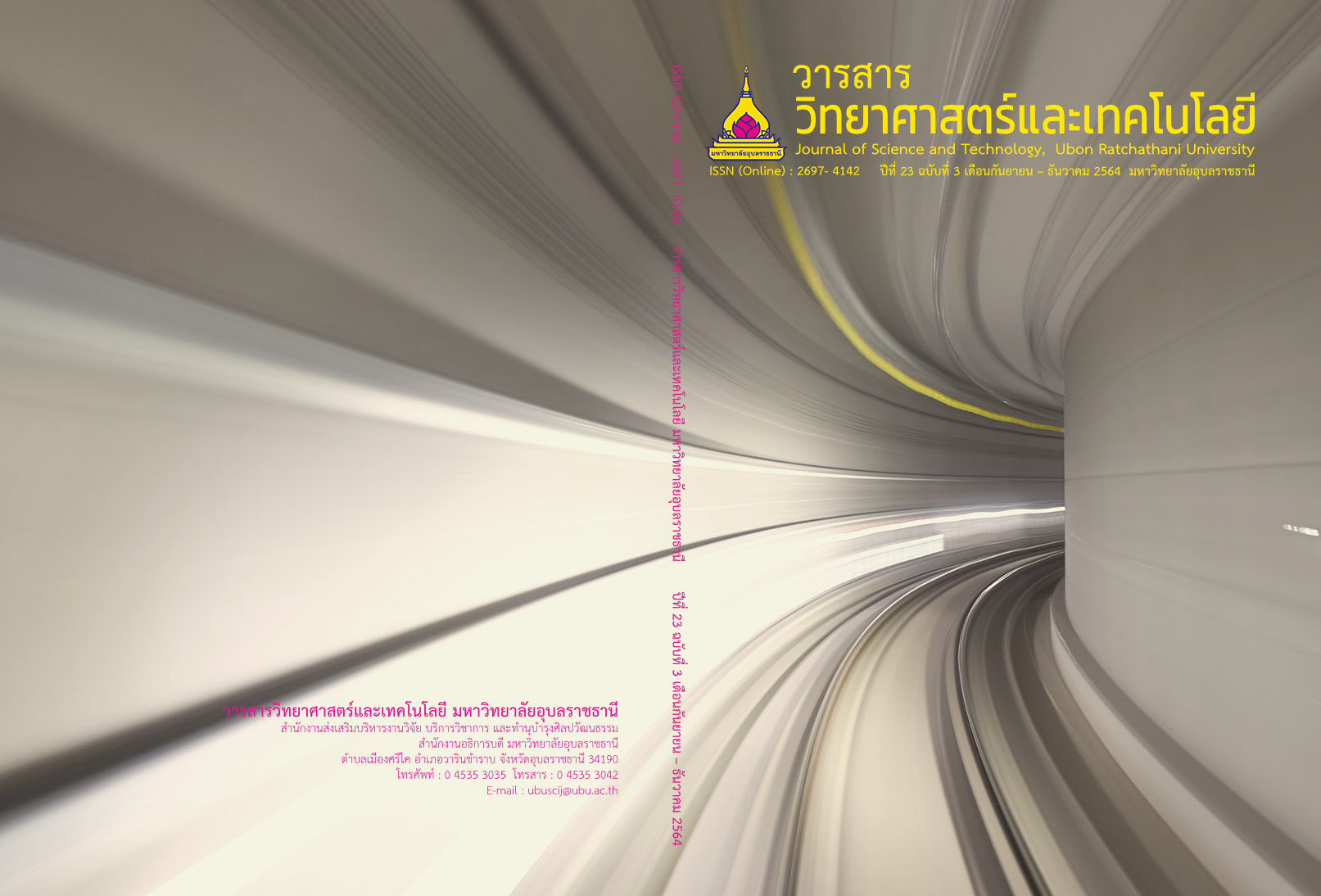สมบัติทางกายภาพ ปริมาณฟีนอลิค และความสามารถในการต้านอนุมูลอิสระของเม่าหลวง
Main Article Content
บทคัดย่อ
งานวิจัยนี้มีวัตถุประสงค์เพื่อศึกษาสมบัติทางกายภาพ ปริมาณฟีนอลิค และความสามารถในการต้านอนุมูลอิสระของเม่าหลวง (Antidesma bunius) ที่ปลูกในเขตเทือกเขาภูพาน จังหวัดสกลนคร นำเม่าหลวงมาแยกเป็นเม่าดำ และเม่าแดง จากนั้นนำเม่าทั้งสองชนิดมาเตรียมเป็น ผลเม่าดำ ผลเม่าแดง เนื้อเม่าดำ เนื้อเม่าแดง น้ำเม่าดำ น้ำเม่าแดง กากเม่าดำ กากเม่าแดง เมล็ดเม่าดำ และเมล็ดเม่าแดง เพื่อใช้ตรวจสอบสมบัติทางกายภาพ ซึ่งได้แก่ ความชื้น water activity (aw) และสี ตรวจสอบปริมาณฟีนอลิคโดยวิธี Folin-Ciocalteu method และตรวจสอบความสามารถในการต้านอนุมูลอิสระ โดยวิธี 2,2-diphenyl-1-picrylhydrazyl (DPPH) assay และวิธี Ferric reducing antioxidant power (FRAP) assay จากการทดลองพบว่าส่วนต่าง ๆ ของเม่ามีสีที่แตกต่างกันจากแดงไปจนถึงม่วง น้ำเม่าแดงมีความชื้น และ aw สูงที่สุด โดยมีค่าเท่ากับร้อยละ 94.29 และ 1.00 ตามลำดับ ส่วนของเม่าที่มีปริมาณฟีนอลิค และความสามารถในการต้านอนุมูลอิสระโดยวิธี DPPH assay และโดยวิธี FRAP assay สูงสุดสามอันดับแรก คือ เมล็ดเม่าดำ ผลเม่าดำ และน้ำเม่าดำ นอกจากนี้แล้วแต่ละส่วนของเม่าดำมีปริมาณฟีนอลิค และมีความสามารถในการต้านอนุมูลอิสระสูงกว่าส่วนเดียวกันของเม่าแดง การศึกษานี้ทำให้ทราบถึงความแตกต่างของการกระจายตัวของสารประกอบฟีนอลิค และฤทธิ์ต้านอนุมูลอิสระในส่วนต่าง ๆ ของเม่าหลวง เพื่อใช้เป็นข้อมูลพื้นฐานสำหรับการพัฒนาผลิตภัณฑ์อาหารและยาจากเม่าหลวงต่อไป
Article Details
บทความที่ได้รับการตีพิมพ์เป็นลิขสิทธิ์ของ วารสารวิทยาศาสตร์และเทคโนโลยี มหาวิทยาลัยอุบลราชธานี
ข้อความที่ปรากฏในบทความแต่ละเรื่องในวารสารวิชาการเล่มนี้เป็นความคิดเห็นส่วนตัวของผู้เขียนแต่ละท่านไม่เกี่ยวข้องกับมหาวิทยาลัยอุบลราชธานี และคณาจารย์ท่านอื่นๆในมหาวิทยาลัยฯ แต่อย่างใด ความรับผิดชอบองค์ประกอบทั้งหมดของบทความแต่ละเรื่องเป็นของผู้เขียนแต่ละท่าน หากมีความผิดพลาดใดๆ ผู้เขียนแต่ละท่านจะรับผิดชอบบทความของตนเองแต่ผู้เดียว
เอกสารอ้างอิง
Sutin, S. 2016. Vitamins and free radicals. Huachiew Chalermprakiet Science and Technology Journal. 1(2): 80-92. (in Thai)
Lobo, V. and et al. 2010. Free radicals, antioxidants and functional foods: Impact on human health. Pharmacognosy Reviews. 4(8): 118-126.
Zymanczyk-Duda, E. and et al. 2018. Natural antioxidants-properties and possible applications. Journal of Applied Biotechnology and Bioengineering. 5(4): 251-258.
Vorarat, S., Intharapithakand, W. and Phrompittayarat, W. 2017. Comparison of analytical method for antioxidant activity between an image processing technique and microplate-DPPH assay. Journal of Science and Technology, Ubon Ratchathani University. 19(3): 147-153. (in Thai)
Sreeramulu, D. and et al. 2013. Natural antioxidant activity of commonly consumed plant foods in India: effect of domestic processing. Oxidative Medicine and Cellular Longevity. 2013: 369479.
Anuck, I., Jatin, S. and Sanjay, B. 2017. Nutritional value, phytochemicals and antioxidant properties of two wild edible fruits (Eugenia operculata Roxb. and Antidesma bunius L.) from Assam, North-East India. Mediterranean Journal of Nutritional and Metabolism. 10(1): 29-40.
Promkhan, S., Sappaso, S. and Saythi, S. 2008. Effect of vacuum drying conditions on Mao powder quality. In: Proceedings of the 5th Kasetsart University Kamphaeng Saen Campus Conference, 8-9 December 2008. Nakhon Pathom, Thailand. (in Thai)
Hemathulin, S. and Sombun, K. 2015. The functional Mao (Antidesma bunius) jelly drink with mucilage. Khon Kaen Agriculture Journal. 43(1): 299-334. (in Thai)
Hematurin, S. 2014. Utilization of purple corn cob mixed with Mao (Antidesma bunius). Khon Kaen Agriculture Journal. 42(3): 300-305. (in Thai)
Suravanichnirachorn, W. and et al. 2018. Effect of carrier type and concentration on the properties, anthocyanins and antioxidant activity of freeze-dried Mao [Antidesma bunius (L.) Spreng] powders. Agriculture and Natural Resources. 52: 354-360.
Butkhup, L. and Samappito, S. 2011. Phenolic constituents of extract from Mao Luang seed and skin-pulp residue and its antiradical and antimicrobial capacities. Journal of Food Biochemistry. 35(6): 1671-1679.
Jitjaroen, W. and et al. 2018. Chemical and chroatic properties of Mao-berry fruit as a key parameter for beverage industry. International Journal of Food Engineering. 4(4): 293-298.
AOAC. 2000. Official Method of Analysis of AOAC International. 17th edition, the Association Official Analytical Chemists. Gaithersburg, MD: AOAC International.
Rongtong, B. and et al. 2018. Determination of water activity, total soluble solids and moisture, sucrose, glucose and fructose contents in osmotically dehydrated papaya using near-infrared spectroscopy. Agriculture and Natural Resources. 52: 557-564.
Campbell, J. and et al. 2021. Evaluation of biochemical juice attributes and color-related traits in muscadine grape population. Food. 10: 1101.
Krongyut, O. and Sutthanut, K. 2019. Phenolic profile, antioxidant activity, and anti-obesogenic bioactivity of Mao Luang fruits (Antidesma bunius L.). Molecules. 24(22): 4109.
Jorjong, S., Butkhup, L. and Samappito, S. 2015. Phytochemicals and antioxidant capacities of Mao-Luang (Antidesma bunius L.) cultivars from Northeastern Thailand. Food Chemistry. 15(181): 248-255.
Khoo, H.E. and et al. 2017. Anthocyanidins and anthocyanins: Colored pigments as food, pharmaceutical ingredients, and the potential health benefits. Food & Nutrition Research. 61(1): 1361779.
Pajareon, S. 2019. Stability of anthocyanin extract from riceberry rice branencapsulated with rice bran protein concentrate under different pH and heating conditions. RMUTSB Academic Journal. 7(2): 205-215. (in Thai)
Mori, K., Sugaya, S. and Gemma, H. 2005. Decreased anthocyanin biosynthesis in grape berries grown under elevated night temperature condition. Scientia Horticulturae. 105: 319-330.
Thonginla, V., Wanwimolruk, C. and Chuaybamroong, P. 2014. Correlation between antioxidant capacities of fruits analyzed with DMPD and phenolic contents, vitamin C, vitamin E and beta-carotene. Burapha Science Journal. 19(2): 93-104.
Schmidt, M., John, W.J. and Mary, A. 2006. Effects of food processing on blueberry antiproliferation and antioxidant activity. Journal of Food Science. 70(6): 389-394.
Sakhunkhu, S., Hanbunjit, C. and Chaiyarit, M. 2014. The studied on Male Mao Luang (Antidesma sp.) genetic diversity in Sakhon-Nakhon by AFLP techniques and comparisons of quantities and activities of antioxidants substance in leaves and flowers of Male Mao luang (Antidesma sp.) genetic diversityin Sakhon-Nakhon. Khon Kaen Agriculture Journal. 42(Suppl.1): 465-472.


